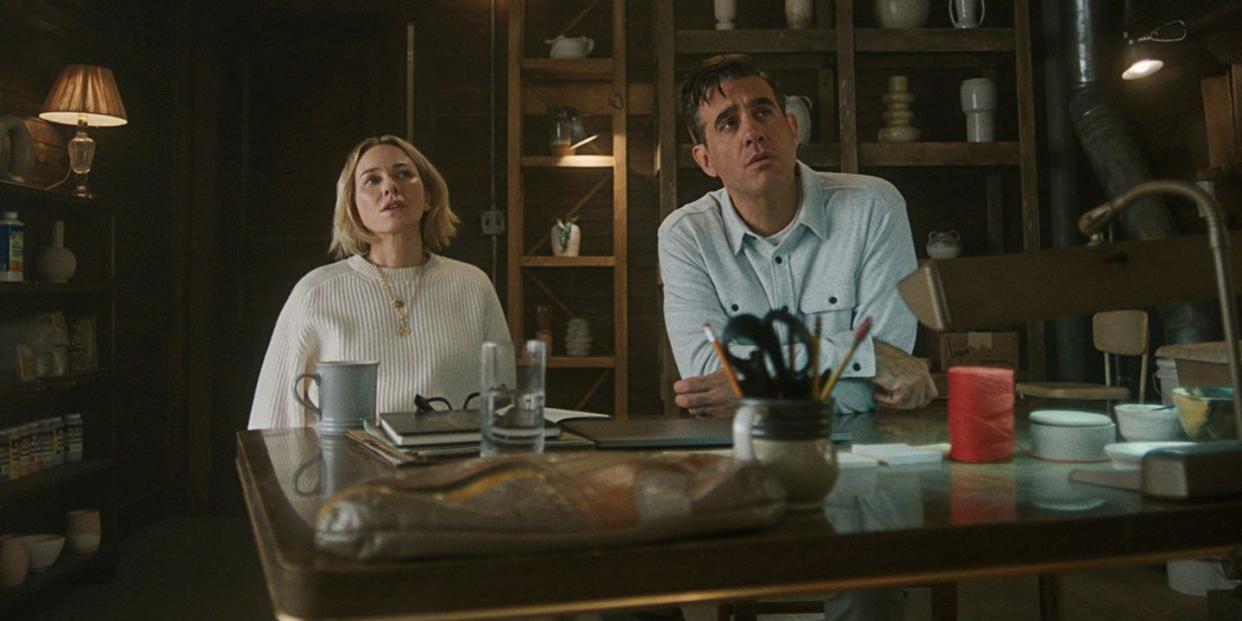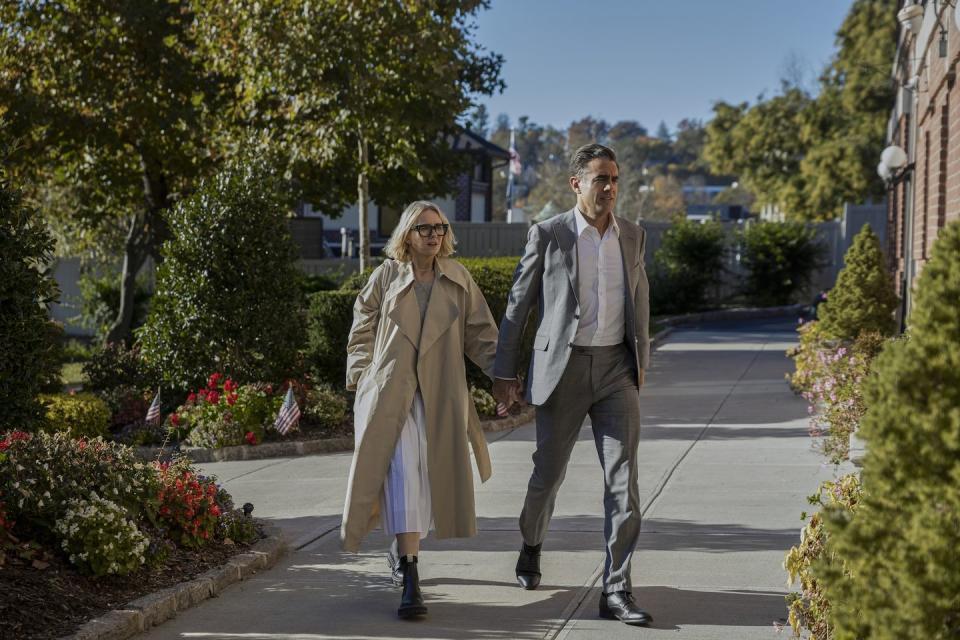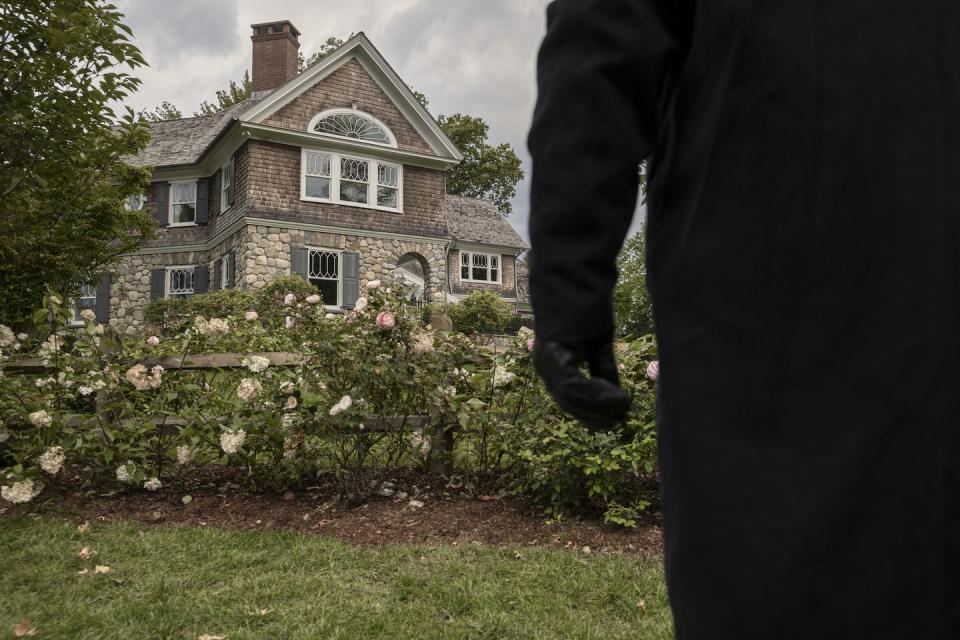'The Watcher' Finale Encourages Your Wildest Theories

Beyond the blood cults, the ostensibly suicidal ferrets, the less-than-neighborly horticulture enthusiasts, and the pigtailed bed invaders, there is, in fact, a solid thesis knitting together Netflix’s intentionally wacky thriller The Watcher. Paranoia feeds obsession, and obsession feeds itself.
This is the character-defining flaw of Dean Brannock (Bobby Cannavale), who indulges his worst instincts when the historic New Jersey mansion he purchases with his wife, Nora (Naomi Watts), and kids, Ellie (Isabel Gravitt) and Carter (Luke David Blumm), starts receiving ominous letters. The incognito letter-writer refers to themself as The Watcher, haunting the Brannock family with cryptic warnings: “657 Boulevard has been the subject of my family for decades now and, as it approaches its 110th birthday, I have been put in charge of watching and waiting for its second coming...It might not frighten you yet, but it will.”
The skeleton of this story is based in truth, originally reported in The Cut and from which the Netflix series is (very loosely) adapted. There is a real 657 Boulevard in Westfield, New Jersey, and starting in 2014 it did receive threatening letters courtesy of an anonymous The Watcher. But Derek and Maria Broaddus, the real-life couple who bought the house, never actually moved into it; they were too terrified by the messages to risk their kids’ safety. By having its own Brannock family move in from the get-go, Netflix’s The Watcher takes significant creative liberties for the sake of drama—and continues to employ them throughout the seven episodes that follow.

Which brings us to the finale, a winding hour of television that posits to tie up loose ends, only to eagerly rip them open again. At the start of episode 7, “Haunting,” the Brannocks are back in New York City, where Nora is reaping the fruits of her Miami Basel-worthy pottery show while Dean struggles (and fails) to forget the mystery of The Watcher. He’s still stuck on the John Graff theory: that one of the former owners of the home—that guy who killed his own family, remember?—posed as 657 Boulevard’s building inspector and warned Dean in-person. John might not be The Watcher, but he’s got to be involved somehow. Nora’s sick of this unending nightmare. “Just admit that we lost,” she demands. “We lost.”
But Dean’s paranoia has honed itself along a razor’s edge. Manhattan is too supposedly threatening for him anymore, especially after a subway-pushing incident earlier that morning. If he can just crack this case, he insists his family will finally be safe. Nora is the only one seeing reason: “We are never going to know.”
The couple then goes to visit Theodora Birch (Noma Dumezweni), the ailing private investigator they hired to dig into The Watcher case. Her cancer has suddenly, rapidly worsened, and she doesn’t have much longer to live. On her deathbed, she makes a last-minute confession to Dean: She’s so very sorry, but spoiler alert—she’s The Watcher. The ensuing tale seems dubious from its first word: Theodora used to own 657 Boulevard, only to lose it due to financial difficulties following a divorce from her husband. When her ex eventually died, she learned he’d stashed away money; a revelation, given she was desperate to buy 657 Boulevard back. So she cooked up The Watcher—as well as John Graff—to scare the Brannocks out of their new home. She hired an actress to slip into Dean’s bed at night, and even manipulated Andrew Pierce (another of the house’s suggestible former owners) into believing he’d received Watcher letters prior to his wife’s suicide.
The logical leaps here are miles wide, though that’s not anything new for the Ryan Murphy-led series. But it’s telling that Dean and Nora both buy it, so desperate are they to believe that any answer—any—is possible, so long as an answer actually exists. So it’s unfortunate that, when Dean pays a visit to neighbor Mo (Margo Martindale), she shuts down Theodora’s confession with nary a wink. “There was never a Black woman living” at 657 Boulevard, she informs Dean. “Not in the 25 years I’ve lived here, at least.” Theodora’s daughter backs up that account: She tells the Brannocks that the PI fabricated the whole testimony in order to grant them peace. They’re dumbfounded, as betrayed as the audience.
Meanwhile, real estate agent Karen (Jennifer Coolidge) is enacting her own vendetta against the Brannock family, after they accused her and Detective Chamberlain (Christopher McDonald) of conspiracy. Through her friends in the media, she’s planted an article laying out evidence that The Watcher letters are coming from the Brannocks themselves, leading Dean to confess to his wife that, well... he did send a few Watcher letters of his own to the neighbors. All’s fair in love and real estate, right? Nora can’t believe he’d be so stupid. She insists he apologize, should he hope for their marriage to survive. So he does—to Mo, anyway—only for their arugula-hungry neighbor to unravel Theodora’s tall tale.

Back at 657 Boulevard, Karen’s not having much better luck with her move-in experience. After the contractors shuttle her new pink marble countertops into the kitchen, she discovers Nora hovering in the corner of the living room. (A Watcher™️!) “So, it was you, all this time,” she says. “Are we really going to go down that road again, Nora?” Karen retorts. “You’re the one who made the big stink about some dumbass letters that weren’t even scary. You’re the one that tanked your own house’s resale value.”
Nora leaves, dissatisfied, in time for Karen to do the unthinkable: She refuses welcome-home pastries from her neighbors (on account of a keto diet, of course). Are we meant to believe it’s mere coincidence that, hours later, she has the first night’s stay from hell? Inexplicably, the bathtub runs long and hot enough to flood through her floors. The dumbwaiter delivers her a Watcher letter. She discovers her dog, dead and alone on the hardwood. (What does The Watcher have against pets?) Finally, a hooded figure rises up from beneath the staircase. One night at 657 Boulevard, and Karen’s already sprinting barefoot away from her new home, screaming for help.
Next door, the Westfield Preservation Society—featuring Pearl (Mia Farrow), Jasper (Terry Kinney), Mo, Roger Kaplan (Michael Nouri), and John Graff/William “Bill” Webster (Joe Mantello)—has already hosted their latest meeting. They’re upset about the pink marble, sure, but distracted by their new membership list. “How’s your family, Bill?” Roger asks, seemingly recognizing Bill as John Graff, the former resident of 657 Boulevard who shot his kids and snipped his face out of any identifiable photographs. “Bill” doesn’t respond. Does The Watcher intend this as a pseudo-confession? We did, after all, see Pearl and “Bill” snaking through the tunnels beneath 657 Boulevard in episode 6. But that doesn’t necessarily mean they’re The Watcher, right?
In therapy, Dean tries to move forward without the family’s tormentor behind bars. He insists he and Nora are doing well, but he can barely answer the counselor’s questions without bringing up the house. “I keep trying to make this story have a happy ending,” he says. “But it’s not going to.”
The scene ensues as a three-minute-long commercial for finding a perceptive therapist. “Five minutes ago, when you were talking about your family? That did sound like a happy ending,” Dean’s therapist notes. “But that’s not how it feels to you, is it?” The line serves as both observation and indictment. The Brannocks made it out alive. But Dean insists some part of him remain in the coffin of his unrealized dream, in the monied illusion he so yearned to make reality.
And so the cycle begins again. A new family moves into 657 Boulevard. Dakota (Henry Hunter Hall), the security contractor who enjoyed a brief romance with Ellie, leaves his card for them to discover when they inevitably need it. Pearl and Jasper chop wood in the backyard. Andrew Pierce sits, sobbing, in a nearby patch of landscaping. Mo observes the house from her lawn chair, peering through her binoculars. And so, too, watches Dean, standing near the driveway and staring at the house that once belonged to him. “Congratulations,” he tells the new owner, Ben. “I’m John.” Sorry, John?
As he pulls away, watching in his rearview mirror as Ben fishes a Watcher letter out of the mailbox, Nora drives up to the house in a car behind him. She looks at her husband, then at the house. Neither of them can move on—or, perhaps, they refuse moving on as a legitimate answer to what they’ve been through. The screen cuts to black, and the credits roll, revealing that the real-life Watcher case remains unsolved. (This is true.)

What are we to make of this? That sense of having your brain blended into a soup is intentional. Everyone is a suspect—including Nora and Dean themselves—even if none of these supposed suspects make any logical sense. The Watcher wants its audience hurtling down rabbit holes, popping back up only to realize they’re miles away from where they started. Might it be Mitch and Mo’s blood cult? Pearl’s preservation society? John Graff, back to finish what he started under a new pseudonym? A tortured Andrew Pierce? Real-estate agent Karen and the Westfield Police Department? Dakota, making a little extra cash from all this fear?
The Watcher—and, by extension, Murphy—isn’t interested in providing the answer. What the show is interested in is the fear itself, that gnawing suspicion that there’s something to be solved, to be saved, if only the knots in the world might be untangled. We live in the age of anxiety; it is somehow easier to cope with the belief that there might be a cult in your basement than a neighbor committing hate crimes on your block. Debunked conspiracies—microchipped vaccines, Wayfair trafficking rings, Pizzagate—feel more plausible than the reality: that a disease has killed millions of people; that the place where the most children in America are harmed is within their own homes.
At one point in the series, Nora and Dean are deliberating over whether to remain in 657 Boulevard. She votes to hold their ground. “We’re not really safe anywhere,” she tells him. “Is that what we should be telling our kids?” But by staying in Westfield, by watching their parents grow increasingly wrapped up in a true-crime obsession with no concrete evidence and no real resolution, Ellie and Carter are convinced of the danger regardless. It’s not just here; it’s everywhere. There are more plot holes in The Watcher than I could count. But they sure look enticing to jump through, don’t they?
You Might Also Like

